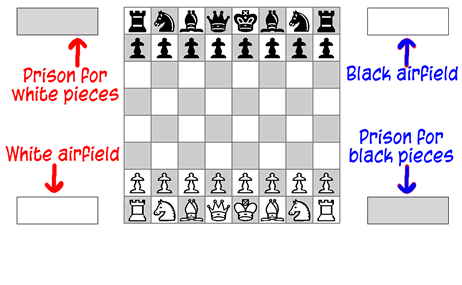
Fascinating, exciting, extremely entertaining — what a wonderful new game!”
— Grandmaster Kevin Spraggett
Mating attacks are the norm. Anyone can hope to discover new principles or opening lines.”
— Grandmaster Larry Kaufman
Every bit as intriguing as standard chess. Beautiful roads keep branching off in all directions, and sharp-eyed beginners sometimes roll right over the experts.”
— FIDE Master Robert Hamilton
With only a few rule changes, Hostage Chess creates a marvelously exciting variant on the classical game.”
— International Master Lawrence Day
Chess is not yet played out, but it is no longer possible to perform at a high level without a detailed knowledge of openings. In Hostage Chess creativity and imagination flourish, and fun returns.”
— Peter Coast,
ex Scottish Champion
Probably the most remarkable chess variant of the last fifty years. Captured men are hostages that can be exchanged. Play is rarely less than exciting, sometimes with several reversals of fortune. Dramatic mates are the rule, not the exception. ”
— D.B.Pritchard, author of "The Encyclopedia of Chess Variants"
It develops your imagination, your sense for the big fish lurking in chess waters. ”
— John Leslie, originator of Hostage Chess
|
If you're new to Hostage Chess, here's a quick overview of how to play the game. We'll assume you already know how to play the game of ordinary chess.
Set up the board and pieces in the usual way. Leave a little extra space beside the board, at both the left and right of each player. Start playing in the usual way. As with regular chess, the goal of the game is to checkmate your opponent's king.
When you capture your opponent's piece, put it at your side of the board, at your right-hand side. This is the prison where pieces are temporarily placed before they can return to the game. (They're hostages, hence the name of the game).
When it is your turn, you can use your move to rescue a piece of yours that your opponent has imprisoned, returning it to an empty square on the board — but you must, as part of the same move, also free one of your opponent's pieces, of equal or greater value. The opponent's freed piece is moved from prison to the airfield — this is the space on your opponent's left side of the board.

So, a move could consist of moving your piece from prison onto an empty square, and also — as part of the same move — freeing your opponent's piece from prison (by moving it from the prison at your right-hand side, directly forward to the airfield on your opponent's side of the board). This is one way of dropping a piece.
As explained, when dropping one of your pieces from prison, you must at the same time free from prison one of your opponent's pieces of equal or greater value. These values are defined in this order:
| Comparative value |
| Queen |
| Rook |
| Knight or Bishop |
| Pawn |
So, your opponent's piece that is freed must be at the same level in the list as yours, or higher.
If your opponent has freed one of your pieces from prison, and moved it to your airfield, you can later in the game use your move to drop that piece back into play, onto an empty square. This is the other way of dropping a piece. (When dropping a piece from your airfield, you don't free one of your opponent's pieces.)
Pieces can be dropped back onto any empty square — the only exception is that pawns may never be dropped onto the 1st or 8th ranks. It's allowable for you to choose to drop a bishop onto the same-colored square as your other bishop.
When your pawn reaches the 8th rank (whether by move or capture), it must be promoted to any of your pieces (i.e. rook, knight, bishop, or queen) that are in prison. The promoted pawn exchanges places with the imprisoned piece. If no such piece is currently in prison, a pawn on the 7th rank cannot move.
One side-effect of this rule is that if you have a pawn on the 7th rank that cannot move (because you don't have a promotion piece in prison), it cannot give check to your opponent's king. It may look like a check, but it isn't — it's called a pseudo-check. Also, a pawn that cannot move cannot prevent your opponent from castling.
A pawn dropped on its normal starting rank (2nd rank) can still move 1 or 2 squares forward on its next move, just as though it had never moved.
A rook dropped back on a corner square counts as an unmoved rook for purposes of deciding whether castling is permitted.
A dropped pawn is never subject to being taken en passant on the next move of the opponent.
|